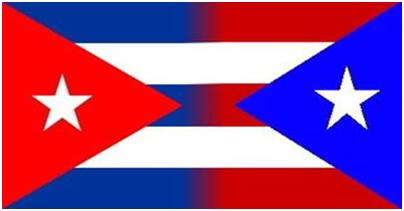The month of June is always full of many events celebrating the Puerto Rican Culture. There are various street festivals along with the National Puerto Rican Day celebrated this month. In honor of these celebrations and of my culture I am providing you all with a brief history on our beautiful bandera.
Back in October 2010 I had the pleasure of attending an exhibit at El Museo del Barrio in Spanish Harlem. The exhibit titled “Nueva York (1613-1945)” was presented in collaboration with the New-York Historical Society and this intriguing exhibition revealed the powerful role that Latinos and Spanish-speaking countries played across four centuries to help shape New York into the most culturally vibrant city in the world. Art works, documents, printed books, artifacts, an installation by Puerto Rican artist Antonio Martorell, and a documentary by Ric Burns all served as testaments to this dynamic history.
I learned many new things at this exhibit, one of them being the history of our beautiful flag. As a Nuyorican, Puerto Rican history was not taught to me in school. Therefore, I find that as an adult I have to teach myself about my heritage and I am willing to share my knowledge with you all.
I always wondered why the Puerto Rican and Cuban Flags looked similar. If you’ve ever wondered the same thing and didn’t know why, here is the reason.

The design of the Puerto Rican flag reflects the close ties that bound the Cuban and Puerto Rican Patriots in the 19th centuries. The flag was first used on December 22, 1895.
A group of 59 Puerto Ricans led by Dr. Julio J. Henna, gathered at “Chimney Corner Hall” in Manhattan and organized a political group (Puerto Rican Revolutionary Committee), which attached to the Cuban Revolutionary Party and advocated independence for Puerto Rico and Cuba from Spanish rule. As part of their activities, a flag was created to rally support for independence from Spain.
Some sources document Francisco Gonzalo Marín with presenting a Puerto Rican flag prototype in 1895 for adoption by the Puerto Rican Revolutionary Committee in New York City at the gathering at Chimney Corner Hall. Marín has since been credited by some with the flag’s design. There is a letter written by Juan de Mata Terreforte, Vice-President of the Puerto Rican Revolutionary Committee, which gives credit to Marin. The original contents of the letter in Spanish are the following:
“La adopción de la bandera cubana con los colores invertidos me fue sugerida por el insigne patriota Francisco Gonzalo Marín en una carta que me escribió desde Jamaica. Yo hice la proposición a los patriotas puertorriqueños que asistieron al mitin de Chimney Hall y fue aprobada unánimemente.”
Which translated in English states the following: The adaptation of the Cuban flag with the colors inverted was suggested by the patriot Francisco Gonzalo Marín in a letter which he wrote from Jamaica. I made the proposition to various Puerto Rican patriots during a meeting at Chimney Hall and it was approved unanimously.
Marín, who decided to have a proper flag sewn based on the prototype, presented the new flag’s design at Chimney Corner Hall and the Puerto Rican Flag (with the light blue triangle) soon came to symbolize the ideals of the Puerto Rican independence movement.
In a letter written by Maria Manuela (Mima) Besosa, the daughter of the Puerto Rican Revolutionary Committee member Manuel Besosa, she stated that she sewed the flag. This created a belief that her father could have been its designer. In her letter she described the flag as one which consists of five stripes that alternate from red to white. Three of the stripes are red, and the other two are white. To the left of the flag is a light blue triangle that houses one white five-pointed star. Each part of this flag has its own meaning. The three red stripes represent the blood from the brave warriors. The two white stripes represent the victory and peace that they would have after gaining independence. The white star represented the island of Puerto Rico. The blue represents the sky and blue coastal waters. The triangle represents the three branches of government.
It may never be known who truly designed the current flag, however what is known is that on December 22, 1895, the Puerto Rican Revolutionary Committee officially adopted the design which represents the current flag. Today however the light blue triangle has been replaced with a darker blue triangle similar to that of the United States Flag.

Good source of information…important to know.
LikeLike